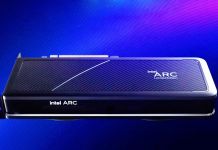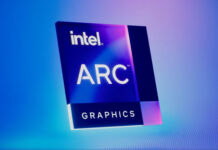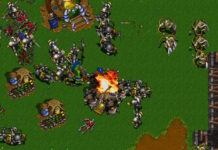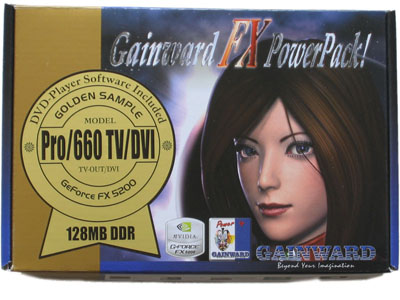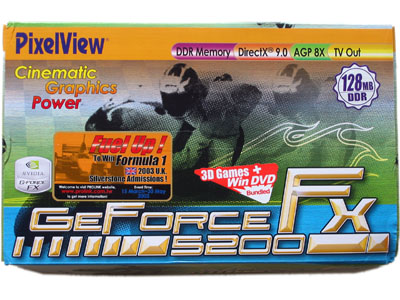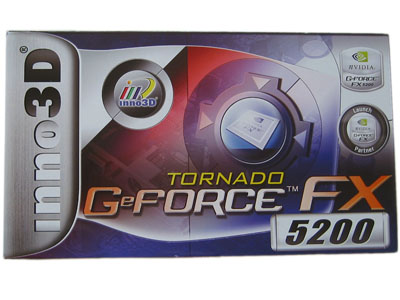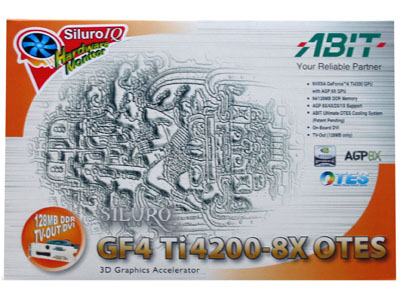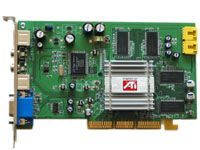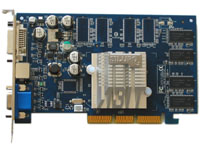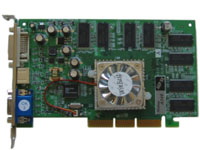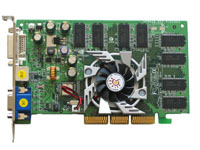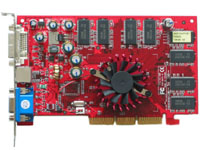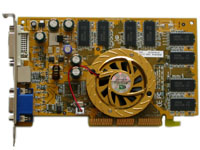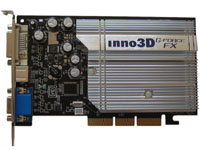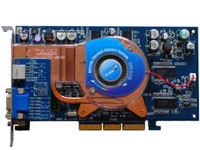As you can see all boards come equipped with 128 MB of VRAM. The two interesting aspects of this review is how 9200 compares to 5200 and how the 5200’s compare internally. We do know beforehand that some manufacturers have chosen to use 64 bit DDR instead of 128 bit on their FX 5200’s. This will certainly handicap performance a great deal. But perhaps some manufacturers have chosen different clockspeeds etc. Let’s find out.
Today we are
going to take a closer look at some videocards for you readers out there on
a tight budget. Most cards are sub-100 dollar cards in this little roundup.
All cards but
two are built on nVidias FX 5200 chip, that is 5200 "non-Ultra".
The remaining is a Radeon 9200 and I also threw in a GF4 Ti4200-8x. Here’s
the lineup:
- Sapphire Atlantis
Radeon 9200 128 MB
- Leadtek Winfast
A340 TDH 128 MB
- Sparkle GeForce
FX 5200 128 MB
- Pixelview GeForce
FX 5200 128 MB
- Gainward FX
PowerPack! Pro/660 TV/DVI Golden Sample 128 MB
- Abit Siluro
FX5200 128 MB
- Inno3D Tornado
GeForce FX 5200 128 MB
- Abit GeForce4
Ti4200-8x OTES 128 MB
Please
note that Abits Ti4200 quite pricier than the other boards in this review. I
simply wanted to give you a picture of what type of performance you get if you
dosh out some more dough. (Besides I was too lazy to do a standalone review
of it 🙂 As you can see all boards come equipped with 128 MB of VRAM. The two
interesting aspects of this review is how 9200 compares to 5200 and how the
5200’s compare internally. We do know beforehand that some manufacturers have
chosen to use 64 bit DDR instead of 128 bit on their FX 5200’s. This will certainly
handicap performance a great deal. But perhaps some manufacturers have chosen
different clockspeeds etc. Let’s find out..
Sapphire Atlantis Radeon 9200
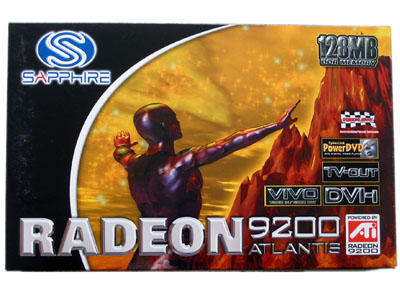
|
Chip: |
RV280
|
Manufacturing process: |
0.15-micron
|
Transistors: |
~36 mil.
|
Core clock speed: |
250 MHz
|
Memory clock speed: |
|
Pixel Shader: |
1.4
|
Vertex Shader: |
1.1
|
Pixel
Pipelines/Pixel Fillrate: |
4
/ 1000 MP/s
|
TMU’s/Texel Fillrate: |
1
/ 1000 MT/s
|
RAMDAC: |
(1) 400 MHz
|
Amount of memory: |
128 MB
|
Type of memory and interface: |
128-bit, DDR-SDRAM
|
In- and outputs: |
VGA, DVI-I, S-Video In/Out, Composite In/Out, Digital Audio In/Out
|
Extra
peripherals: |
ViVo-dongle,
DVI-VGA adapter
|
Software: |
Redline,
Drivers, ATi Multimedia Center etc.
|
Full version applications: |
Pinnacle
Studio ATi Version, PowerDVD XP
|
Estimated price: |
999 SEK
|
For those of
you who are not familiar with Radeon 9200 it goes like this. 9200 is based
on 9000 which in turn is a stripped down version of Radeon 8500. The 9200
brings AGP 8x compability over the 9000. The stripping down part involved
removing the fixed function TnL unit and one TMU from the 8500. By looking
at the shader specifications we can tell that this is a DirectX 8.1 class
product. The FX boards in this roundup are however DirectX 9 boards.
 Front
Front |
|
 Back
Back |
|
Passive cooling
is certainly welcomed. The board layout is as you can see very clean. Since
this board sports ViVo functionality it is equipped with the Rage Theater
chip. As far as cosmetics goes the board looks very "plain". The
PCB is fitted with 4 x16 MB RAm capsules on each side for a grand total of
128 MBs VRAM.
 Front
Front |
|
 Back
Back |
|
To the left you
have a closer look at the passive cooling sollution. I expect that this is
ATis reference design and judging by the temperatures I’d say it does its
job just fine. Actually the heatsink isn’t even luke warm even after running
at maximum OC for half an hour. The memory on the board are 4ns Hynix TSOP
chips which is rated for 500 MHz operating speed. Since the memory is only
clocked to 400 MHz this should mean that there’s some headroom for overclocking
depending on latency and timings and voltage etc.
All in all the board layout
and cooling works very well.
|
Design/Cooling
|
We
takes a look at the functional and aesthetical design. The performance
and sound level of the cooling is also very important. |
|
 Front IO
Front IO |
|
 Back IO
Back IO |
|
When it comes
to features and accessories Sapphires board has both advantages and weaknesses.
First of all let’s talk about the advantage. The word here is ViVo, Video
In and Video Out. Sapphire offers S-Video and Composite for both input and
output. The board also handels digital audio. In fact Sapphire is the only
manufacturer to offer ViVo in this roundup. To utilize the Video In functionality
Sapphire has bundeled ATis MultiMedia Center version 7.8 along with WDM-drivers
and a video editiong tool from Pinnacle. Personally I really like ATis MMC
bundle. Basically because MMC offers a unified media center just as the name
implies.
 Back
Back |
|
Sapphire
don’t bundle any game with this low end videocard but they do have their Redline
tool for overclocking and tweaking which is developed by the Rage3D
crew. This tool is the most powerful tweaker I’ve ever seen bundled with a
videocard. It supports driver tweaking, overclocking, tweakage hotkeys, per
game profiles, refreshrate overriding and custom resolutions etc. etc. Very
nice indeed though I personally rather use Rage3Ds own tool Rage3D Tweaker
which has the same functionality but seems to be updated more often. For watching
DVDs they’ve used PowerDVD XP which works just fine. The only minus I can
come up with is basically the lack of any games. But since this board has
ViVo and a powerful tweak/OC utility as well as video editing software etc.
I tend to think that more than makes up for the lack of a game.
 Redline
Redline |
|
The
one thing that is missing however is dual monitor capability, though it supports
both VGA/CRT and DVI-I, it only supports one at a time.
|
Accessories/Features
|
We
look at the amount and usefulness of included accessories and integrated
features. |
|
Abit Siluro FX5200

|
Chip: |
NV34
|
Manufacturing process: |
0.15-micron
|
Transistors: |
~45 mil.
|
Core clock speed: |
250 MHz
|
Memory clock speed: |
|
Pixel Shader: |
2.0
|
Vertex Shader: |
2.0
|
Pixel
Pipelines/Pixel Fillrate: |
4
/ 1000 MP/s
|
TMU’s/Texel Fillrate: |
1
/ 1000 MT/s
|
RAMDAC: |
(2) 400 MHz
|
Amount of memory: |
128 MB
|
Type of memory and interface: |
64-bit, DDR-SDRAM
|
In- and outputs: |
VGA, DVI-I, S-Video Out
|
Extra
peripherals: |
S-video
cable, S-Video-Composite adapter
|
Software: |
WindowsBlinds
NV Edition, Soldier of Fortune II Demo, Earthviewer 3D Demo
|
Full version applications: |
Siluro
DVD 4
|
Estimated price: |
814 SEK
|
Abit has lower
memory clock frequencies than the other FX 5200 manufacturers, on top of that
they even chose to go with a 64 bit memory bus instead of 128 bit which will
severely handicap performance.
 Front
Front |
|
 Back
Back |
|
Once again here’s
another board with passive cooling, very nice. As we can see this board only
has 4 RAM capsules, which according to the manufacturer, Nanya, is each 16
MBs. This would be 4x 16 = 64 MB of total VRAM. But yet RivaTuner and Detonator
FX report the board as having 128 MBs and also a 128 bit memory bus. I really
don’t know what’s up with this but as you will see later the performance really
seem to indicate that it is indeed 64 MB/64 bits instead of 128 MB/128 bits.
 Cooling
Cooling |
|
 Memory
Memory |
|
I’m sad to say
that the passive cooling on this board does in no way perform as good as the
one on Sapphires. The heatsink gets incredibly hot just after a short while.
The memory used is manufactured by Nanya and is rated 6 ns which is 333 MHz
DDR. So basically it’s running just in spec with not much headroom for anything
else.
From a purely
cosmetic standpoint I personally think this is the best looking card in this
roundup. The heatsink design and the dark blue PCB really looks very cool.
|
Design/Cooling
|
We
takes a look at the functional and aesthetical design. The performance
and sound level of the cooling is also very important. |
|
 IO
IO |
|
When it comes to input
and output Abit delivers the standard stuff. DVI and VGA/CRT out and S-video
out.
 Software and accessories
Software and accessories |
|
Software is a
bit worse, apart from the Siluro DVD this package has no full version software
at all. Three demo application/games but only Soldier of Fortune II is kind
of interesting. We also find that the bundle has no DVI-VGA adapter nor does
it have a composite cable.
|
Accessories/Features
|
We
look at the amount and usefulness of included accessories and integrated
features. |
|
Leadtek
Winfast A340 TDH
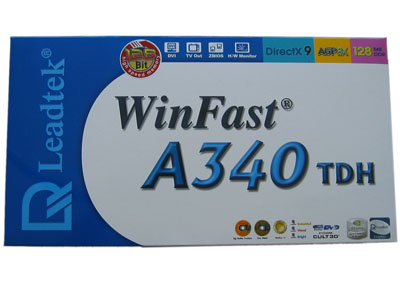
|
Chip: |
NV34 |
Manufacturing
process: |
0.15-micron |
Transistors: |
~45 mil. |
Core
clock speed: |
250 MHz |
Memory
clock speed: |
|
Pixel Shader: |
2.0
|
Vertex Shader: |
2.0
|
Pixel Pipelines/Pixel Fillrate: |
4
/ 1000 MP/s
|
TMU’s/Texel Fillrate: |
1
/ 1000 MT/s
|
RAMDAC: |
(2) 400 MHz |
Amount
of memory: |
128 MB |
Type
of memory and interface: |
128-bit, DDR-SDRAM |
In-
and outputs: |
VGA, DVI-I, S-Video Out |
Extra
peripherals: |
S-video
and composite cables, DVI-VGA dapater, S-Video-Composite adapter
|
Software: |
WinFox
II, Cult3D, Coloreal |
Full
version applications: |
WinFastDVD,
Big Mutha Truckers and GunMetal |
Estimated
price: |
984 SEK |
Leadteks board
looks pretty anonymous, but that’s pretty far from the truth which we’ll see
further down the page.
 Front
Front |
|
 Back
Back |
|
The board is
equipped 8 x 16 MB RAM for a full 128 MB on a 128 bit bus.
 Cooling
Cooling |
|
 Memory
Memory |
|
The fan on this
board is the loudest of all cards tested today except Abits OTES cooling.
It’s not very loud compared to a high end board but for a low end board it’s
a bit too noisy. The memory used is manufactured by Samsung and is rated 4
ns which corresponds to 500 Mhz DDR.
|
Design/Cooling
|
We
takes a look at the functional and aesthetical design. The performance
and sound level of the cooling is also very important. |
|
 IO
IO |
|
When it comes
to inputs and outputs Leadtek delivers the standard stuff.
 Software and accessories
Software and accessories |
|
Leadtek bundles
two pretty hot games: GunMetal which is one of the first games developed using
nVidias Cg and Big Mutha Truckers which is a pretty neat racing title. For
DVD they use their own WinFastDVD 3.1 application. The coolest thing in the
bundle is WinFox II though. This little application has loads of features.
Too many to put on this page. Amongst the nicer stuff we have voltage and
temperature monitoring. Judging by the picture you see below other cards will
even grant control over voltage and fan speed settings, this board however
just allows monitoring.
The other features include color calibration, driver information, subsystem
diagnostics etc. all in all a very cool tool, though I personally find the
design pretty horrible with all the loud colors and different GUIs for different
parts of the application etc.
 WinFox II
WinFox II |
|
|
Accessories/Features
|
We
look at the amount and usefulness of included accessories and integrated
features. |
|
Sparkle GeForce FX 5200
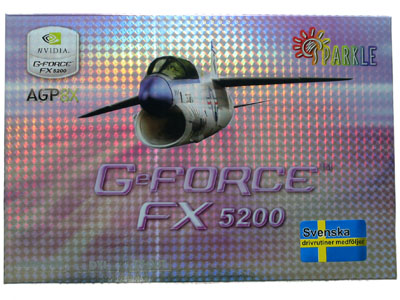
|
Chip: |
NV34 |
Manufacturing
process: |
0.15-micron |
Transistors: |
~45 mil. |
Core
clock speed: |
250 MHz |
Memory
clock speed: |
|
Pixel Shader: |
2.0
|
Vertex Shader: |
2.0
|
Pixel Pipelines/Pixel Fillrate: |
8
/ 1000 MP/s
|
TMU’s/Texel Fillrate: |
1
/ 1000 MT/s
|
RAMDAC: |
(2) 400 MHz |
Amount
of memory: |
128 MB |
Type
of memory and interface: |
128-bit, DDR-SDRAM |
In-
and outputs: |
VGA, DVI-I, S-Video Out |
Extra
peripherals: |
S-video
cable, DVI-VGA dapater
|
Software: |
Drivers,
PowerDVD 3 demo |
Full
version applications: |
– |
Estimated
price: |
1099 SEK |
Yet another
board running at 250/400 MHz. In case you’re wondering why there’s a Swedish
flag on the box it simply says "Swedish drivers included". Whoopeee…
😉
 Front
Front |
|
 Back
Back |
|
Nothing really
special here, the board has a 8 x 16 MB RAM configuration. The HSF looks like
it’s made out of plastic, feel like plastic too. I don’t know what’s up with
that.
 Cooling
Cooling |
|
 Memory
Memory |
|
The fan works
flawlessly, it cools the chip and it’s completely silent. I tried shutting
down my harddrives and turning off the other fans in my rig and I can assure
you that it is impossible to hear any noise at all from this fan. Very neat.
As for memory Sparkle chose 5 ns (400 Mhz DDR) TSOP DDR from Samsung. In other
words this board runs the memory just within the specs without even a single
Mhz to spare.
|
Design/Cooling
|
We
takes a look at the functional and aesthetical design. The performance
and sound level of the cooling is also very important. |
|
 IO
IO |
|
Here we go again:
CRT/VGA, DVI and S-Video. It’s pretty much universal on all videocards today.
 Software and accessories
Software and accessories |
|
When it comes
to Sparkles bundle a single word comes to mind: pathetic. They haven’t bundled
anything at all. They don’t even supply any DVD software, not even all cables/adapters
are included which is pretty annoying since this board isn’t even that cheap
compared to the others. A demoversion of an old outdated version of PowerDVD
is included, they didn’t even go for a demo of PowerDVD XP.
|
Accessories/Features
|
We
look at the amount and usefulness of included accessories and integrated
features. |
|


